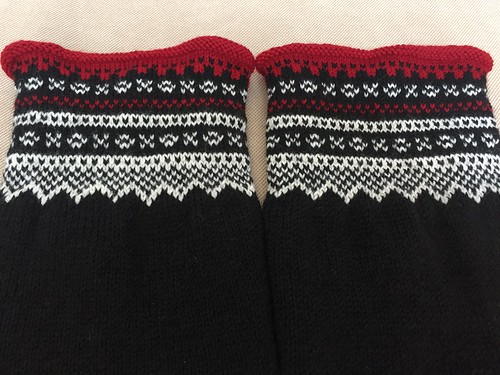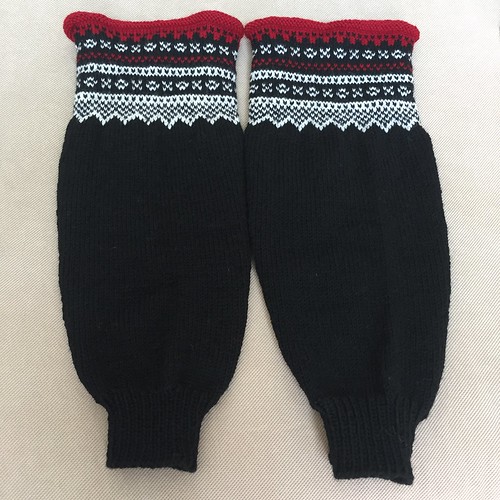Sunday, March 26, 2017
Sleeves Achieved
I finally got the red yarn I needed for my Marius Sweater sleeves in the mail on Friday and quickly went to work finishing up the sleeves.
I'd wanted to get the sleeves completed first to make sure that I was making the armhole steeks the correct height for the sleeves. Several pictures I'd seen of knitters who have attempted this pattern show that the armholes are bit smaller than the sleeves, resulting in some bunching when they are sewn in. I'm thinking that if I know exactly how side the sleeve openings are, I can try and make my steek for the armholes match. That's the plan, anyway.
I'm pleased with how the stranded knitting portion looks. I was a little worried that the white/black combination might be too stark, but like most stranded knitting, it looks a bit better from afar. The fabric does pull in a bit where the white yarn starts, but that's too be expected. I haven't blocked this yet, so I'll be able to add a bit of stretch. I'll need to do that anyway before I measure for the armhole steeks.
I switched from the grayish green Petroleum color for the highlights, collars and seams to the more traditional red, and I think it was the right decision. The grey was kind of sickly looking and just didn't add enough contrast. The red, which is the traditional color for this part of a Marius sweater, is perfect. I was a little worried that it wouldn't pop against the black enough, but it does just fine. If it looks like the sleeves are a bit short, that's okay. This is a drop-sleeve construction, so the sleeve seems are supposed to fall a few inches down from the natural drop in a person's shoulder. I normally don't like this kind of sweater -- I prefer set-in sleeves -- but it's kind of what you have to put up with for stranded knitting. It's possible to do a capped sleeve in fair isle, but way more complicated. And this, ultimately isn't that complicated a garment.
A testament to this is the two pages of instructions. They seem a bit sparse to me, with no schematics of how the pieces fit together. Translated from Norwegian and written in the mid-20th century, I think the designer made certain assumptions about the person reading this person -- their skill, competence, and knowledge of knitting in general. I've been able to follow pretty well, except for a strange few missing stitches toward the top of the pattern charts. Usually, this denotes that some sort of decrease has taken place, although there is nothing in the written instructions that would indicate I'm supposed to do that. After consulting with experts, I came to the conclusion that this indicated a re-set point. All the stitches are supposed to work right and left from a mid-point on the outer edge of the sleeve. You count out from that point to find out where on the chart you start and stop, depending on the size you're knitting. For most of the chart, that's based on a 10-stitch repeat, but for the last few rounds, it shifts to a 4-stitch repeat. So I just reset from that point to figure out a new starting point that resulted in the pattern matching across the whole grid. This is a bit difficult to discuss without showing the pattern, but I didn't want to do that. Trust me when I say that this took up a LOT of time trying to figure out, and that whether I'm right or wrong, I'm satisfied with the explanation I've told myself. At this point, please, don't correct me if I'm wrong! The reverse stockinette at the top is mean to be hidden when the sleeves are attached.
So now it's just back to the body of the sweater and inches and inches and rounds and rounds of knitting with black yarn on black needles connected with a black cord. I'm sitting under very good light, but it can be a bit of a challenge. I'm eagerly looking forward to the stranded portion at the top of the body of the sweater, which is similar to, but much more elaborate than those on the sleeves.
As I've tried to find out more about this pattern, I'm stunned at how ubiquitous it is and almost universally recognized in Norway. So many cool things out there. I know things are warming up around here, but next time you have a cool snap, keep your eyes open!
Subscribe to:
Posts (Atom)






